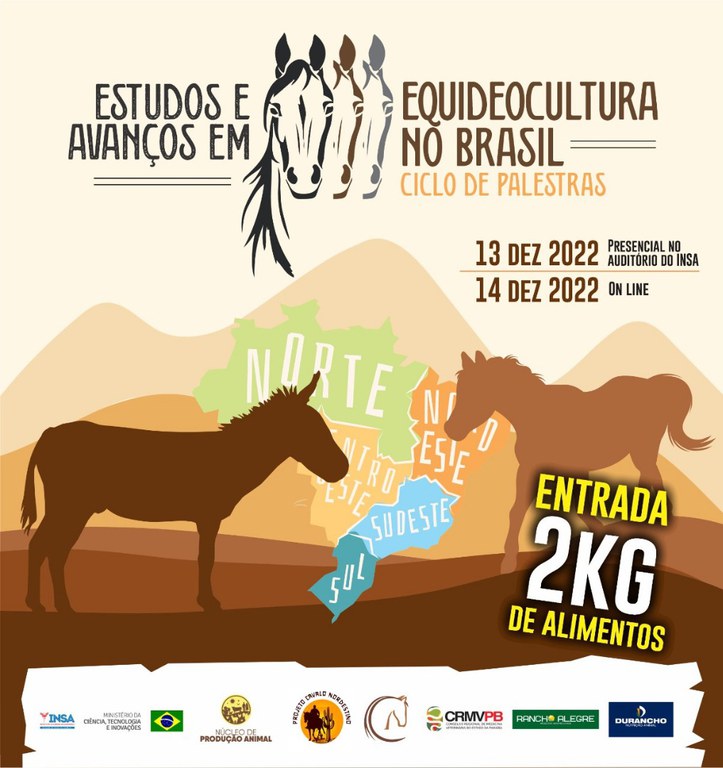Nutrição e alimentação de asininos e muares
Abstract
O processo evolutivo imprimiu características únicas aos jumentos. Além das diferenças fenotípicas entre os jumentos e os equinos, existem grandes diferenças que têm efeito positivo na digestão da fibra alimentar em jumentos. Os estudos de nutrição são limitados para os jumentos e muares. Embora suas exigências nutricionais ainda não foram definidas, considera-se que sejam cerca de 25% mais baixas que a de equinos. Os principais problemas nutricionais observados em jumentos e muares estão relacionados ao excesso de ingestão de energia, fato devido a esses animais serem alimentados como se fossem equinos, acarretando superalimentação. Como estratégias nutricionais, recomenda-se que tanto jumentos como muares sejam alimentados com dietas com teor elevado de fibras (>20% fibra bruta), dando preferência a alimentos volumosos como pastagens, fenos e palhas. Alimentos volumosos de qualidade aumentam o fornecimento de energia, sem a necessidade do fornecimento de alimentos concentrados, e essa é a principal estratégia de manejo alimentar para estes animais. A suplementação com rações só deve ocorrer em casos de extrema necessidade. Já está comprovado que o concentrado pode reduzir o aproveitamento da fibra dietética pelos jumentos e muares. Outra importante recomendação é que jumentos e muares de trabalho devem ter acesso a água limpa, sombra e alimento volumoso, a cada 4 horas de trabalho indicado como intervalos para descanso.
References
Burden, F. Practical feeding and condition scoring for donkeys and mules. Equine Veterinary Education, v. 24, n. 11, p. 589–596, 2012.
Burden, F.; thiemann, A. Donkeys are differentJ. Equine Vet. Sci. Elsevier Ltd, 2015. ttps://doi/10.1016/j.jevs.
Cuddeford, D. et al. Digestibility and gastro-intestinal transit time of diets containing different proportions of alfalfa and oat straw given to Thoroughbreds, Shetland ponies, Highland ponies and donkeys. Animal Science, v. 61, n. 2, p. 407-417, 1995.
Izraely, H. et al. Factors determining the digestive efficiency of the domesticated donkey (Equus asinus). Wiley Online Library, v. 74, n. 1, p. 1–6, 1989. https://doi/abs/10.1113/expphysiol.
Wood, Shephanie Jane. Some factors affecting the digestible energy requirements and dry matter intake of mature donkeys and a comparison with normal husbandry practices. 2010.
JERBI, H. et al. Anatomical and morphometric study of gastrointestinal tract of donkey (Equus africanus asinus). Journal of Morphological Sciences, v. 31, n. 1, p. 18–22, 2014.
LIMA MENEZES, M. 2017. Digestibilidade aparente dos nutrientes e metabolismo energético de equídeos submetidos à dietas com diferentes fontes energéticas. Tese, Universidade de São Paulo, Faculdade de Zootecnia e Engenharia de Alimentos da USP, Pirssununga, 2017, 73p.
Liu, Li-Lin et al. Effect of Dietary Forage/Concentrate Ratio on Nutrient Digestion and Energy and Protein Metabolism in Adult Donkeys. Animals, v. 10, n. 6, p. 1025, 2020.
Liu, G., et al. Microbial diversity within the digestive tract contents of Dezhou donkeys. PLoS One, v. 14, n. 12, e0226186, 2019.
Liu, H. et al. Comparative study of gut microbiota in Tibetan wild asses (Equus kiang) and domestic donkeys (Equus asinus) on the Qinghai-Tibet plateau. PeerJ, v. 8, p. e9032, 2020.
Martin-Rosset, W. Donkey Nutrition and Feeding: Nutrient Requirements and Recommended Allowances—A Review and Prospect. J. Equine Vet. Sci., p. 1–11, 2018. https://doi.org/10.1016/j.jevs.2018.01.014.
National Research Council (NRC). Donkeys and other equids. In Nutrient Requirements of Horses, 6th ed.; National Research Council, Ed.; National Academies Press: Washington, DC, USA, 2007; pp. 268–279.
Norris, S. L.et al. Global donkey and mule populations: Figures and trends. PLoS ONE, v. 16, n. 2, 2021.
Pearson, R. A. Nutrition and feeding of donkeys. Veterinary Care of Donkeys; Mathews, NS, Taylor, TS, Eds, 2005.
Pearson, R. A. et al. Intake, digestion and gastrointestinal transit time in resting donkeys and ponies and exercised donkeys given ad libitum hay and straw diets. Equine Veterinary Journal, v. 23, n. 5, p. 339–343, 1991.
Pearson, R. A.et al. The effect of forage quality and level of feeding on digestibility and gastrointestinal transit time of oat straw and alfalfa given to ponies and donkeys. British Journal of Nutrition, v. 85, n. 5, p. 599-606, 2001.
Pearson, R. A. et al. A comparison of the effect of forage type and level of feeding on the digestibility and gastrointestinal mean retention time of dry forages given to cattle, sheep, ponies and donkeys. British Journal of Nutrition, v. 95, n. 1, p. 88-98, 2006.
Smith, D.G.; Burden, F.A. Practical donkey and mule nutrition. Equine applied and clinical nutrition, v. 1, p. 304-316, 2013.
Smith, D. Gaylord; PEARSON, Robert A. A review of the factors affecting the survival of donkeys in semi-arid regions of sub-Saharan Africa. Tropical Animal Health and Production, v. 37, n. 1, p. 1-19, 2005.
Xing, Jingya et al. The composition and predictive function of the fecal microbiota differ between young and adult Donkeys. Frontiers in Microbiology, v. 11, p. 596394, 2020.
Zhang, Ruiyang et al. Unveiling the biogeography and potential functions of the intestinal digesta-and mucosa-associated microbiome of donkeys. Frontiers in microbiology, v. 11, p. 596882, 2020


